 Back in January 2017, in the first review ever published on SoundStage! Simplifi, Al Griffin wrote, “What makes me think the wireless category has finally, truly arrived are new options from companies such as Dynaudio and Devialet—wireless, powered speakers that provide high-performance alternatives to traditional wired hi-fi systems.” Al was evaluating the Bang & Olufsen Beosound 2 in that review, and he wrote it with serious listeners in mind for whom the sound system—its performance and its continual refinement—is an important part of the experience.
Back in January 2017, in the first review ever published on SoundStage! Simplifi, Al Griffin wrote, “What makes me think the wireless category has finally, truly arrived are new options from companies such as Dynaudio and Devialet—wireless, powered speakers that provide high-performance alternatives to traditional wired hi-fi systems.” Al was evaluating the Bang & Olufsen Beosound 2 in that review, and he wrote it with serious listeners in mind for whom the sound system—its performance and its continual refinement—is an important part of the experience.
The Beosound 2’s low-reaching, “prodigious” bass and its ability to “fill a room with detailed, dynamic sound” surprised and impressed Al. Noting its lack of room equalization and placement inflexibility, Al concludes his review by affirming that he “really liked listening with the Beosound 2 and certainly enjoyed looking at it.” And so, when an opportunity arose to review Bang & Olufsen’s Beosound Balance, the company’s latest omnidirectional offering, it was an easy yes.
Design
Bang & Olufsen (B&O) is widely acclaimed for its industrial design, having a long legacy of strikingly distinct products. The company’s website provides some insight into how they achieve such distinction. Several quotes from key personnel resonated with me. From Kresten Bjørn Krab-Bjerre, the company’s creative director and concept developer: “We start by looking at architecture, and it serves as preparation before the designers arrive.” From David Lewis, the company’s late chief designer: “Who says that loudspeakers should hide away in corners if the closer they get to you, the better they sound?” And in an interview for the Wall Street Journal, Lewis said, “We wouldn’t dream of doing something that wouldn’t hold. This is part of the culture.” Design as a group effort is also part of the culture at B&O, which has allowed the company to create new, ground-breaking products—not only from an acoustic perspective but also from an aesthetic one.
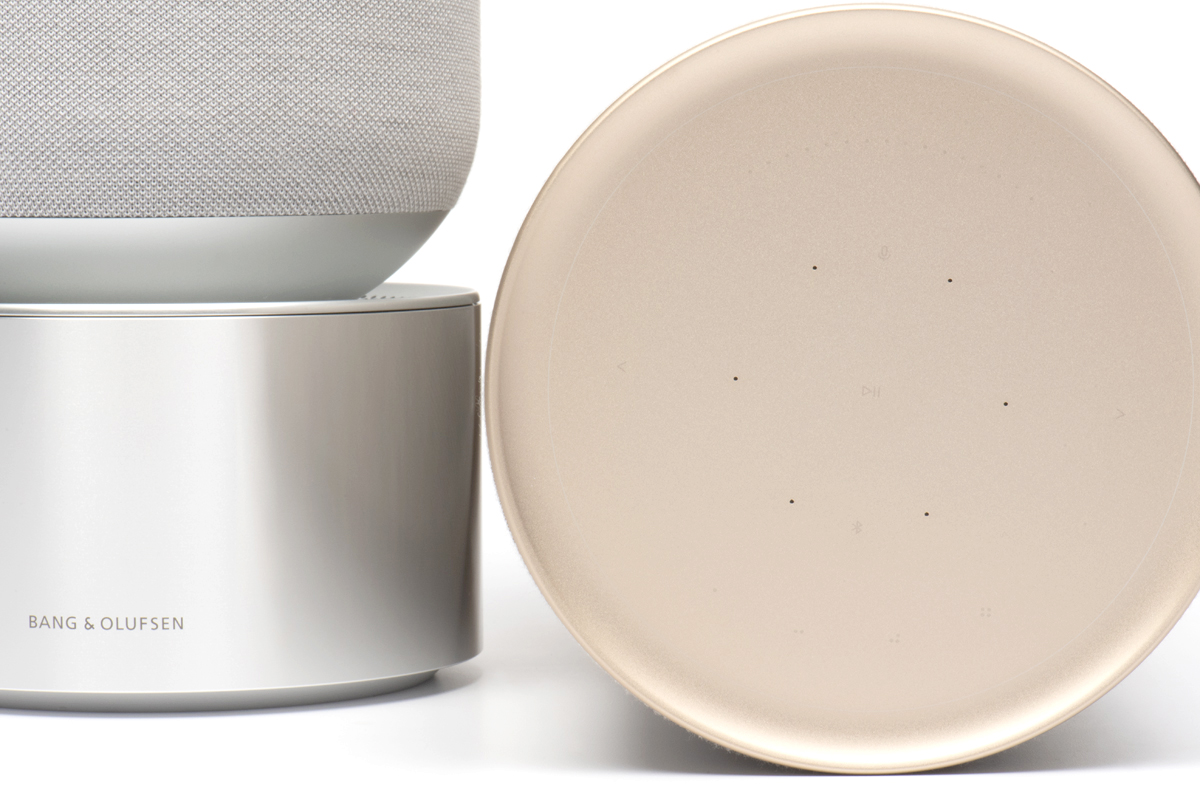
In a video meeting with B&O’s Malte Erich Elborg, senior manager of product planning, and Clément Lebel, senior global project manager, the two elaborated on the company’s visual philosophy. The goal is striking a balance between optimal sound and pleasing aesthetics, Malte explained. From the Fibonacci-inspired pattern on the base of the Beosound Balance to its wool-covered wires, B&O’s sensibility to form is patently evident.
But form follows function at B&O and, by way of illustration, Malte mentioned a few notable aspects of utility of the Beosound Balance and their other products: controller app, voice control via Google Assistant, and a proximity sensor so that the speaker’s touch controls illuminate when you approach it. The 16 LEDs along one edge of the top panel grow brighter or dimmer when you move your finger to adjust volume. Other controls on the top of each speaker let you pause and resume playback, skip tracks, or choose one of four preset internet radio stations.
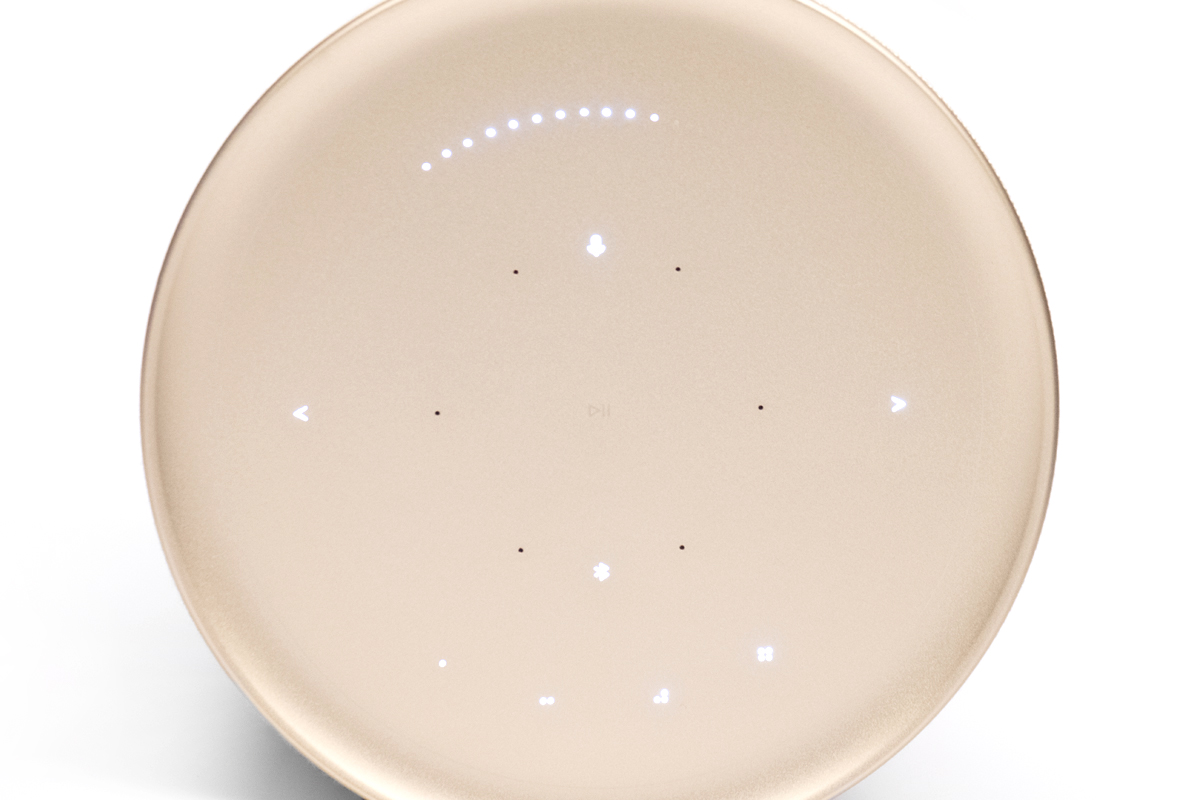
B&O offers the Beosound Balance in four attractive finishes: Natural Oak ($3,149, all prices USD), Black Oak ($3,149), Natural Aluminium ($3,399), and White Marble ($3,699). The oak and aluminum finishes come with color-coordinated accents on the base and top, and their wool covering has a hint of white for contrast. The White Marble finish is accented with contrasting copper-colored aluminum on the base and top.
Technology
As I was about to find out, a single Beosound Balance speaker is great for casual (monaural) listening. For a more engaging experience, two can be paired stereophonically. Each enclosure houses seven drivers, each with its own class-D amplifier: a 0.75″ tweeter powered by an 80W amp; two 2″ and two 3″ full-range drivers, each powered by a 100W amp; and two 5.25″ woofers, each powered by a 200W amp (specified as non-clipped peak values, not RMS values). This adds up to 880W of built-in amplification! Frequency response is specified as 26Hz–23kHz; no deviation figure is provided. With so much power packed into a small package, I was eager to hear how the Beosound Balance would perform as a mono tabletop speaker and as a stereo pair.
With drivers set both in the base of the speaker and around its core, the Beosound Balance is capable of radiating sound omnidirectionally. One of the two woofers is housed facing up in the base, its sound emanating through a concave, intricately perforated aluminum grille. The second, down-firing, woofer resides in the upper part. Above it is the single tweeter, and above that, near the top, are the two outwardly angled 2″ drivers. Also near the top are the two 3″ drivers, each angled about 120 degrees from center on the right and left sides (facing backward).

The Beosound Balance supports dual-band Wi-Fi and Bluetooth 5.0 (SBC codec with Android, SBC and AAC codecs with iOS). Concealed within a recess on the underside of the speaker are the physical connections: a USB Type C service port, a combined 3.5mm line-in/optical jack, a two-prong power inlet, and two ethernet ports. The cables pass through a notch at the back, which allows a clean installation.
The Beosound Balance supports Apple AirPlay and Chromecast, so listeners can stream audio from any app on an iOS device or a Macintosh and any Chromecast-enabled app. Spotify Connect and Tidal Connect are also supported, allowing the transfer of playback from the respective apps to the speaker.
Setup
The two sample units B&O sent me for this review had different finishes: one was in Natural Oak, the other in Natural Aluminium. After unpacking, my first task was to install the B&O app on my iPhone and create an account. Having done that, I was presented with a button to link to a speaker. The app found the two Beosound Balance speakers quickly, installed firmware updates, and gave me the option to pair them. The whole process took all of four minutes.

The B&O app allows the user to easily configure and control linked B&O speakers. You can use the app to add new speakers, stream music from your phone’s music library, and, as mentioned, access preset internet radio stations. A long press on one of the four preset buttons on each speaker sets/resets it to the playing station. When I selected a station using a preset button, my selection was reflected in the app. As I changed the volume, by swiping around the periphery of the touch-sensitive top of a speaker, the volume indicator in the app rose and fell in sync.
The app offers five preset listening modes, whose tonal balance (treble and bass) can be adjusted by dragging a dot over a circular figure. Pinching the dot in or out changes the spaciousness of the sound, from focused to room filling. A custom listening mode can also be set up, named, and saved. When testing a single speaker, I used the pre-programmed Optimal preset to get the full effect of the seven drivers. The general direction of the sound can be set to left, front, and right by selecting the corresponding icon. A fourth icon sets an omnidirectional radiation pattern.
The Sound Settings menu lets you create a stereo pair, activate room compensation, enable/disable loudness, change the line-in sensitivity (high, medium, low, disabled), and toggle the fade-in effect on or off.
The app even has an alarm feature that can be programmed to play a selected radio station when activated. I set up the alarm to test this feature and programmed a second, tone alarm to go off one minute later. As promised, the first alarm overrode the music I was playing with the selected radio station and then, a minute later, overrode the radio station with a ping. Touching the speaker top turns the alarm off. This feature would be most convenient if you want to ensure a broadcast of interest starts playing on time.
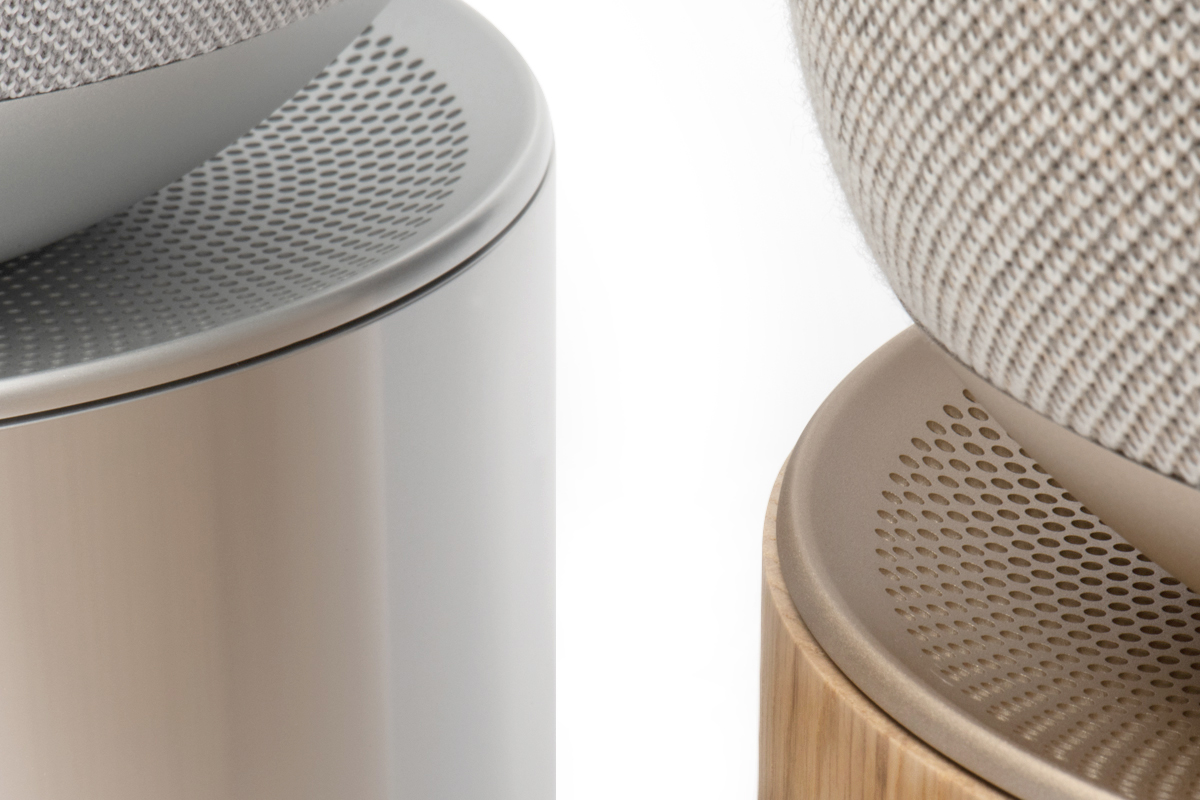
Another feature I appreciated is the ability to set the volume level on power-up as well as the maximum volume level since I often forget to turn the volume down at the end of a playback. The Beosound Balance app allows easy, flexible, extensive customization of the listening experience.
Listening
When paired, each Beosound Balance speaker radiates forward like a conventional speaker. To test the sound difference between a stereo pair and a dual-mono pair, I set one speaker in the middle of my kitchen and one in my living room and tapped one of the preprogrammed internet radio stations. I then unpaired the speakers, so each operated independently in mono. The sound in each room was noticeably fuller as the entire complement of drivers was employed in each speaker, not just the forward-firing ones. Walking around, in either room, I noticed little variation in sound. I could not discern any nodes, nor could I sense being off-axis. In the omnidirectional mode, the sound was large and spacious wherever I was in the room. It was not louder; it was deeper, in both my reflective tile-and-granite kitchen and my absorptive rug-and-upholstery living room.
I switched from web radio to Spotify and listened to the latest single from Derek Smalls of Spinal Tap fame, “Must Crush Barbie” (320kbps Ogg Vorbis, Immortal Records / Spotify). The song begins with what sounds like a lullaby played on an old-fashioned mechanical music box. The sound of a shattering glass abruptly turns this into a heavy, bass-laden Derek Smalls rant, reminiscent of “Stonehenge,” from the 1984 This is Spinal Tap soundtrack, about how we must crush Barbie. The Beosound Balance handled this transition with ease. The bass was full and well defined; the drums and cymbals, including the hi-hats and snares, were crisp; and the vocals were clear and clearly delineated. There was no loss of clarity even with the volume well above 70%. Everything the song presented was handled well.
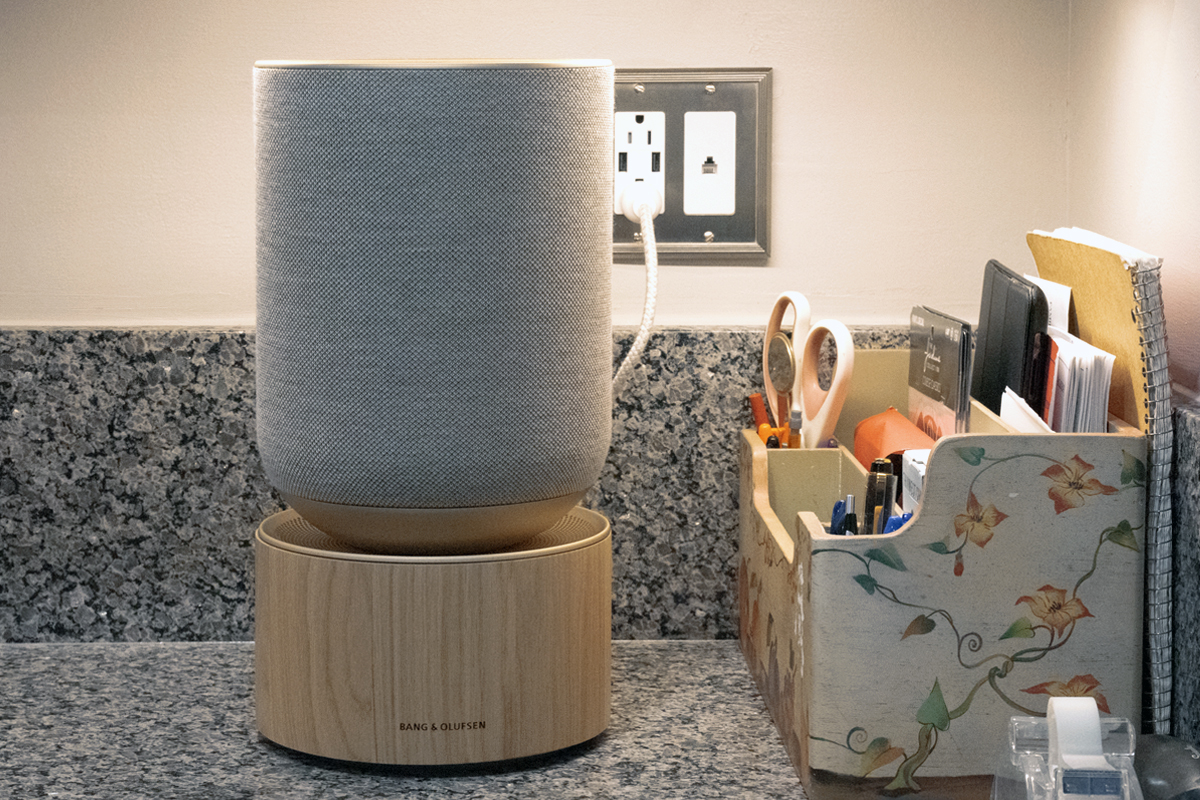
To test the Beosound Balance’s active room-compensation function, I placed one speaker on the granite countertop in my kitchen, in a corner under a cabinet. I listened for a while without room compensation and then engaged it. After a false start—the speaker was too close to the wall, which reflected too much background noise—a frequency sweep sounded, and then the app indicated that the speaker was optimally set for the room. I continued with my Spinal Tap theme and played “The Majesty of Rock,” from their 1992 release Break like the Wind (320kbps Ogg Vorbis, Geffen Records / Spotify). A kitchen is far from an ideal listening space, but the Beosound Balance filled it well. Room compensation, in optimizing the speaker’s dispersion pattern to the room it’s in, eliminated glaring reflections and allowed the speaker, tucked in a corner and surrounded by hard surfaces as it was, to still sound great. And if it handled the kitchen so well, I expected it would work well in any room.
Sure enough, I tested the Beosound Balance in various other locations in the house, with and without room compensation, and found that the sound was consistently less cluttered when compensation was engaged. Without room compensation, especially in the kitchen, the bass seemed to overpower the higher frequencies; with room compensation, the top end didn’t lose any of its clarity. The Beosound Balance sounded good even without room compensation, and the improvement in sound after engaging it was subtle; but once heard, it could not be disregarded.
Next, I set the two speakers along the long wall of my 22′ × 13′ living room, just over 9′ from my listening position. I placed each speaker on a small end table, 24″ high, on each side of the TV, 5′ apart and 15″ from the wall.
The iconic soundtrack theme of The Exorcist, from Mike Oldfield’s 1973 debut album, Tubular Bells (16/44.1 AIFF, Virgin), returns in a new rendition in the latest reincarnation of this film, The Exorcist: Believer. I recently saw the trailer and, curious to hear how this music would sound on the Beosound Balance, I streamed it to the speakers from my MacBook Pro via AirPlay. The haunting refrain in the first 50 seconds was clear and crisp. The piano was offset slightly left of center, the triangle emerged farther to the right, while the bass guitar lurked deep in the background, joining at 0:50 from center stage. Piano chords, at 2:04, appeared from the right in marked contrast to the bass, which the speakers, at only a little more than 50% volume, conveyed cleanly, deeply, and fully. I could feel it in my feet across the room. As the piece builds up in complexity, the soundstage became more and more full, but it never felt cluttered.
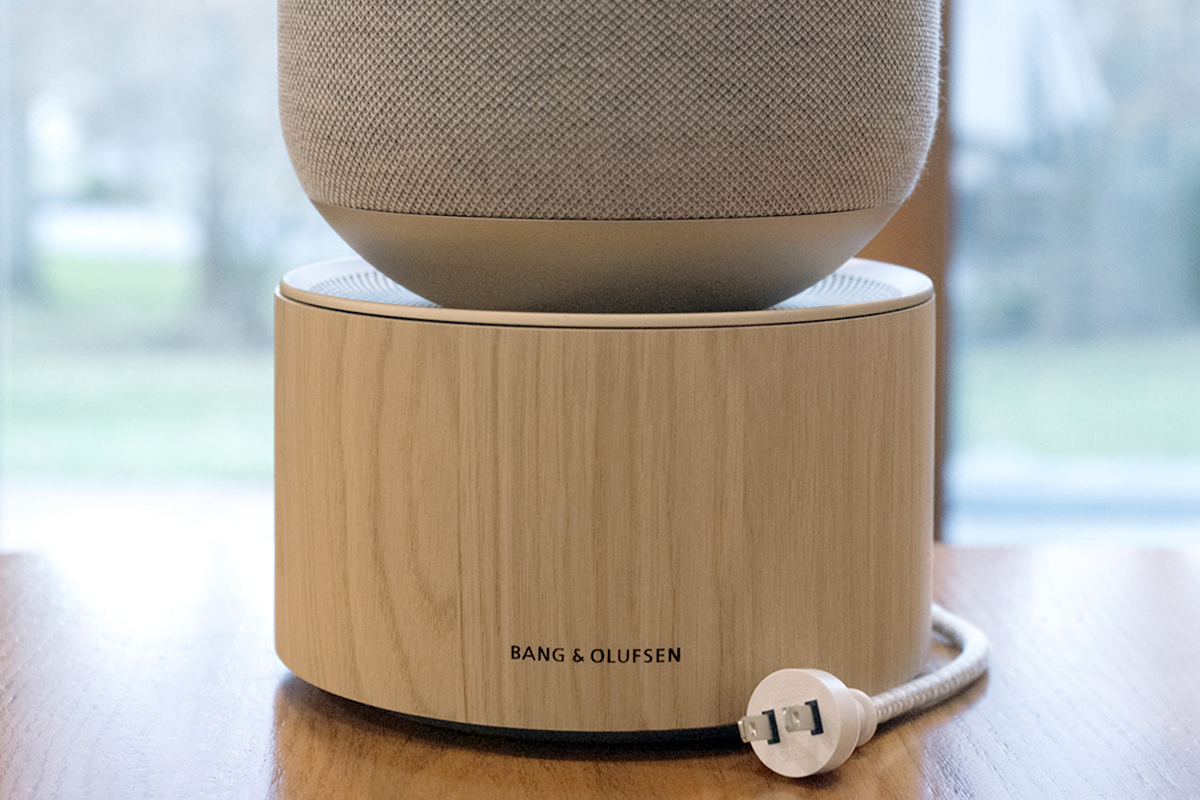
At the 17-minute mark, the soundstage became noticeably wider, but there was a distinct hum in the background, underlying the reverb of the strings, subtly changing every few seconds. I was compelled to pause the music to make sure it was the recording, not the speakers. At around the 20-minute mark, various instruments begin to be introduced, with Oldfield’s voice coming in clearly from the left. I particularly enjoyed the glockenspiel as it moved left to right, set back just to the right of center. The introduction of the tubular bells was smooth and clear. At 75% volume, however, the speakers were close to overpowering the room. I had to turn the volume down and listen to the concluding part once again. When everything faded out save a lone guitar, I was left to reflect on what I just heard. The Beosound Balance handled everything the Oldfield track had to offer with aplomb. From the simplest passages to the most complex, from the soft reverberation of guitar strings to the in-your-face clanging of bells, the performance of these speakers on this recording was downright impressive.
I switched to Jet Records’ 1977 release of Out of the Blue (16/44.1 AIFF) by Jeff Lynne and the Electric Light Orchestra. The brief intro of the opening track, “Turn to Stone,” starts with a whisper but quickly crescendos, growing in shape and depth. It felt as if the music were coming from several feet behind the wall. The first chorus begins at 0:47 as the last hit of the hi-hat can be heard fading and Lynne’s lyrics take over. This is one busy song, but nothing was lost. The sharp contrast of the booming bass with the falsetto just before the two-minute mark demonstrated the power of these small speakers and their control. Once again, a great deal of depth and punch was on display at both ends of the spectrum.
A slight delay when resuming playback after a pause reminded me that I had enabled the fade-in feature. The violins remained prominent as the song began its descent and started to fade out; there was no bloating in the bass. I really appreciated how clean everything was.
Comparison
In my first article for SoundStage!, I wrote about my fleet of Devialet Silver Phantom speakers (discontinued; $2390 each when available). Like the Beosound Balance, the Silver Phantom is a compact all-in-one active speaker that can be used on its own or paired with another. It is a natural candidate for comparison with the Beosound Balance.
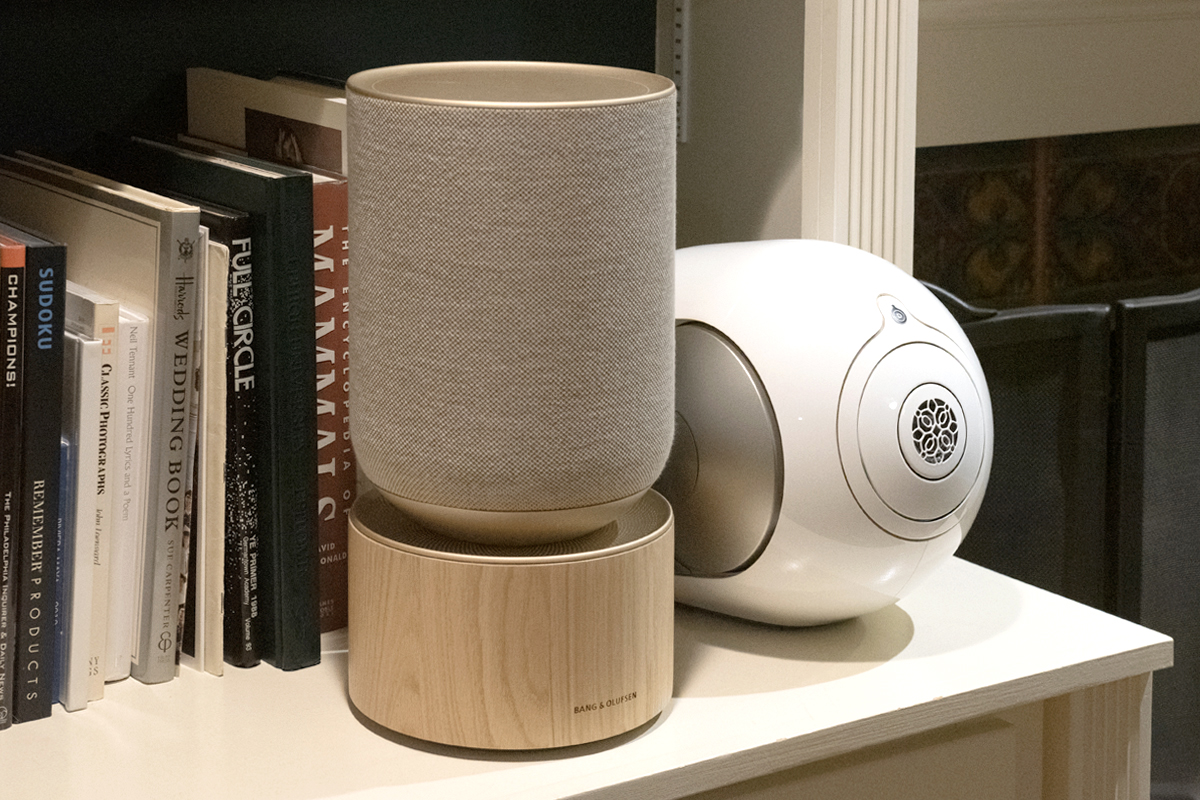
Adele’s “Rolling in the Deep,” from her 2011 album 21 (16/44.1 AIFF, Columbia/XL), was a compelling demonstration of the Beosound Balance speakers’ ability. The slight echo of Adele’s voice was more pronounced than with the Devialets and lingered a while longer. I did not notice any difference at all in the bass drum, an essential playback component for me. When the chorus was pushed, it sounded smoother with the Beosound Balance speakers and not as hard compared to the Silver Phantoms. The background vocals were clearer, too, especially in the high register. By the time the song ended, I had to concede my preference for the Beosound Balance speakers over my Silver Phantoms.
Both the Beosound Balance and Silver Phantom sounded good in a single-speaker setup, but the soundstage was more spacious with the Beosound, and the sound was bigger. This was most evident in the omnidirectional mode, but it was also noticeable in a directional mode (left/front/right). As a standalone speaker, the Beosound Balance, at least in the Optimal listening mode, sounded better than a Devialet Silver Phantom at any volume and wherever it was in my home.
Conclusion
In my inaugural feature for Simplifi, I wrote about how happy I was with my Devialet Silvers. I still am. I love their sound, their shape, and flexibility. All the same, I would replace each one with a Beosound Balance without hesitation, especially as standalone speakers. The Beosound Balance is designed with the modern listener in mind: an app controlled high-performance wireless speaker that is small and easy to use and is lovely to behold and to listen to.
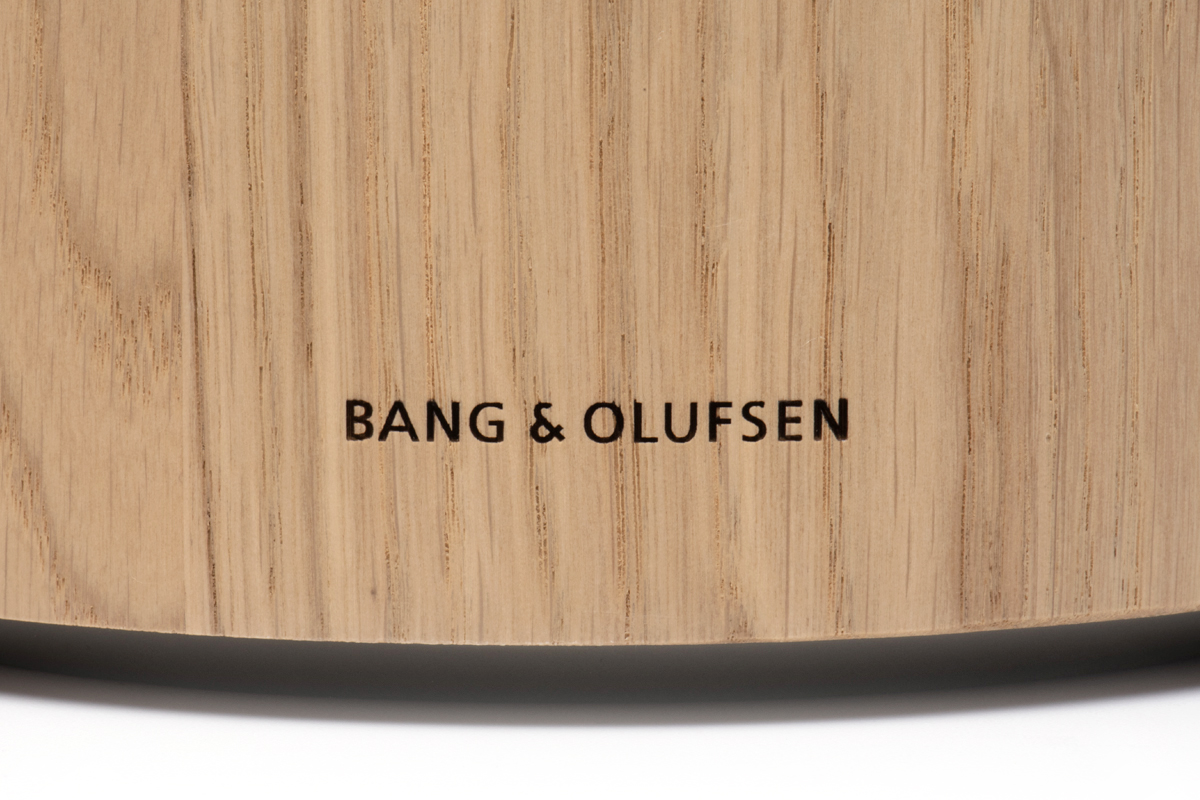
I highly recommend the Beosound Balance to listeners who want beautiful sound without having their speaker (or speakers) be the focal point of the room. The Beosound Balance’s design is subtle. It doesn’t look like a speaker, certainly not like a satellite speaker, as the Silver Phantom does. In fact, right up until it is turned on, it may reasonably be mistaken for a lamp—a very attractive one at that.
Hans Wetzel, my brother and fellow SoundStage! reviewer, wrote in a 2019 article for SoundStage! Access, “For the last few years I’ve felt that if I were ever to depart from SoundStage!, I’d probably sell my traditional hi-fi rig of passive loudspeakers driven by a massive integrated amplifier-DAC, and grab a pair of Devialet Phantoms—e.g., the Silver Phantoms I reviewed on SoundStage! Access a couple years ago.” He has restated this position every time I ask him about upgrading my system: “A sound system for the TV? You have the Phantoms; a test bed for new gear? You have the Phantoms.” I love my Phantoms, but I love the Bang & Olufsen Beosound Balance speakers just a bit more.
. . .Kurt Wetzel
Associated Equipment
- Active loudspeakers: Devialet Silver Phantom.
- Sources and control devices: Apple iPhone 11 running Spotify 8.8.76.704; Apple MacBook Air running iTunes 12.9.5.5.
Bang & Olufsen Beosound Balance Active Loudspeaker
Price: $3,149–$3,699 each, depending on finish.
Warranty: Three years, parts and labor.
Bang & Olufsen A/S
Bang og Olufsen Allé 1
7600 Struer
Denmark
Phone: +45 96 84 11 22
Website: www.bang-olufsen.com




